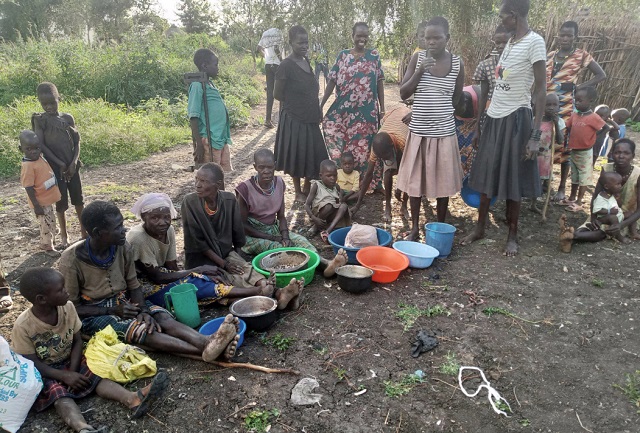Elderly Karimojong women after getting their food rations recently sent to Karamoja by the National Unity Platform in response to the hunger situation in northeastern Uganda (NUP). COURTESY PHOTO
800 million people around the world affected
In the week Ugandan legislators from the northeastern region of Karamoja shed tears on national television due to the alarming hunger situation in their home districts, a UN report warned that the situation could get worse.
The 2022 ‘State of Food Security and Nutrition in the World (SOFI)’ that was published on July 6 shows that world hunger and malnutrition is getting worse not better.
The report notes that nearly 670 million people (8% of the world population) will still be facing hunger in 2030 – even if the global economy will have recovered from the effects of COVID-19 pandemic and the Russia-Ukraine war.
The report shows that the number of hungry and malnourished people in 2030 will be similar to that of seven years ago in 2015 when the goal of ending hunger, food insecurity and malnutrition by the end of this decade was launched under the ‘2030 Agenda for Sustainable Development.’

The hungry rise
According to the SOFI, the number of people affected by hunger globally was 828 million in 2021. That is 46 million more people than in 2020. The number of hungry people is up by 150 million since the outbreak of the COVID-19 pandemic.
This global figure of hungry people includes about 518,000 Karimojong (Approx. 40% of the Ugandan pastoral community’s population). This number is facing “high levels of food insecurity” according to the Integrated Food Security Phase Classification (IFPC) report of June.
“There is a real danger these numbers will climb even higher in the months ahead. The global price spikes in food, fuel and fertilizers that we are seeing as a result of the crisis in Ukraine threaten to push countries around the world into famine,” David Beasley, the executive director of the UN’s World Food Programme said.
“The result will be global destabilization, starvation, and mass migration on an unprecedented scale. We have to act today to avert this looming catastrophe.”
The report notes that the ongoing war in Ukraine, involving two of the biggest global producers of staple cereals, oilseeds and fertilizer, is disrupting international supply chains and pushing up the prices of grain, fertilizer, energy, as well as ready-to-use therapeutic food for children with severe malnutrition.
Supply chains had already been adversely affected by increasingly frequent extreme climate events, especially in low-income countries, something which had already sobering implications for global food security and nutrition.
The report highlights the intensification of major drivers of food insecurity and malnutrition: conflict, climate extremes, and economic shocks, combined with growing inequalities.
“The issue at stake is not whether adversities will continue to occur or not, but how we must take bolder action to build resilience against future shocks,” the heads of the five UN agencies wrote in the foreword in this year’s report.
“These are depressing figures for humanity,” said Gilbert F. Houngbo, the outgoing president of the UN’s International Fund for Agricultural Development (IFAD) during the release of the report in Rome, “We continue to move away from our goal of ending hunger by 2030.”
“We need a more intense approach to end hunger,” he added and warned the ripple effects of the global food crisis will most likely worsen again next year.
The 2022 edition of SOFI was jointly published by the Food and Agriculture Organisation of the United Nations (FAO), the International Fund for Agricultural Development (IFAD), the United Nations Children’s Fund (UNICEF), the UN World Food Programme (WFP) and the World Health Organisation (WHO).
The report presents updates on the food security and nutrition situation around the world, including the latest estimates of the cost and affordability of a healthy diet. It also looks at ways in which governments can repurpose their current support to agriculture to reduce the cost of healthy diets, mindful of the limited public resources available in many parts of the world.


